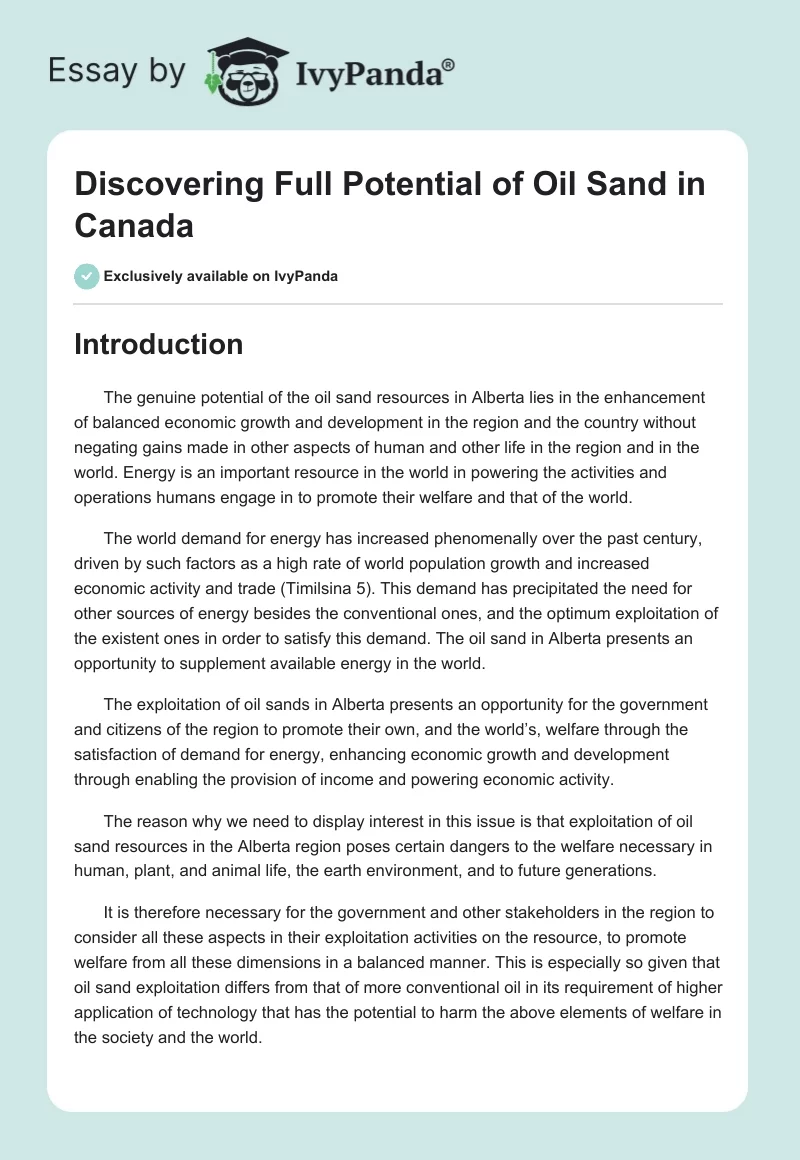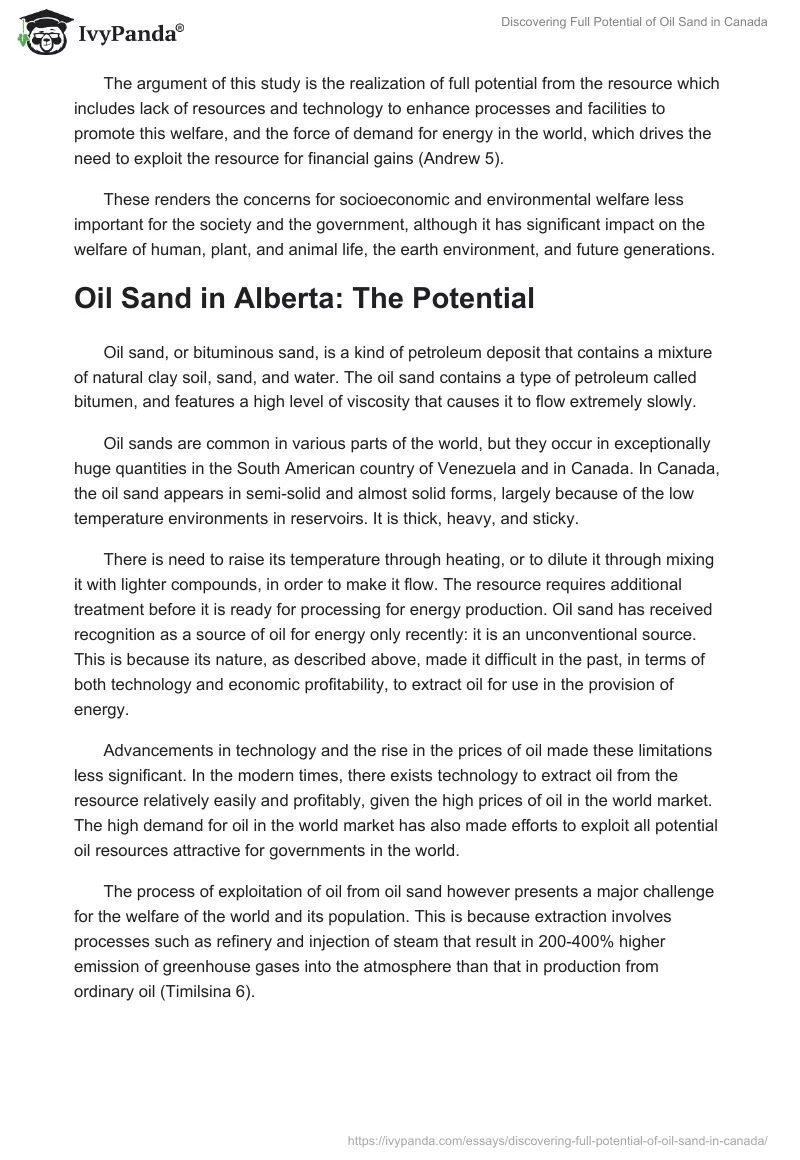Introduction
The genuine potential of the oil sand resources in Alberta lies in the enhancement of balanced economic growth and development in the region and the country without negating gains made in other aspects of human and other life in the region and in the world. Energy is an important resource in the world in powering the activities and operations humans engage in to promote their welfare and that of the world.
The world demand for energy has increased phenomenally over the past century, driven by such factors as a high rate of world population growth and increased economic activity and trade (Timilsina 5). This demand has precipitated the need for other sources of energy besides the conventional ones, and the optimum exploitation of the existent ones in order to satisfy this demand. The oil sand in Alberta presents an opportunity to supplement available energy in the world.
The exploitation of oil sands in Alberta presents an opportunity for the government and citizens of the region to promote their own, and the world’s, welfare through the satisfaction of demand for energy, enhancing economic growth and development through enabling the provision of income and powering economic activity.
The reason why we need to display interest in this issue is that exploitation of oil sand resources in the Alberta region poses certain dangers to the welfare necessary in human, plant, and animal life, the earth environment, and to future generations.
It is therefore necessary for the government and other stakeholders in the region to consider all these aspects in their exploitation activities on the resource, to promote welfare from all these dimensions in a balanced manner. This is especially so given that oil sand exploitation differs from that of more conventional oil in its requirement of higher application of technology that has the potential to harm the above elements of welfare in the society and the world.
The argument of this study is the realization of full potential from the resource which includes lack of resources and technology to enhance processes and facilities to promote this welfare, and the force of demand for energy in the world, which drives the need to exploit the resource for financial gains (Andrew 5).
These renders the concerns for socioeconomic and environmental welfare less important for the society and the government, although it has significant impact on the welfare of human, plant, and animal life, the earth environment, and future generations.
Oil Sand in Alberta: The Potential
Oil sand, or bituminous sand, is a kind of petroleum deposit that contains a mixture of natural clay soil, sand, and water. The oil sand contains a type of petroleum called bitumen, and features a high level of viscosity that causes it to flow extremely slowly.
Oil sands are common in various parts of the world, but they occur in exceptionally huge quantities in the South American country of Venezuela and in Canada. In Canada, the oil sand appears in semi-solid and almost solid forms, largely because of the low temperature environments in reservoirs. It is thick, heavy, and sticky.
There is need to raise its temperature through heating, or to dilute it through mixing it with lighter compounds, in order to make it flow. The resource requires additional treatment before it is ready for processing for energy production. Oil sand has received recognition as a source of oil for energy only recently: it is an unconventional source. This is because its nature, as described above, made it difficult in the past, in terms of both technology and economic profitability, to extract oil for use in the provision of energy.
Advancements in technology and the rise in the prices of oil made these limitations less significant. In the modern times, there exists technology to extract oil from the resource relatively easily and profitably, given the high prices of oil in the world market. The high demand for oil in the world market has also made efforts to exploit all potential oil resources attractive for governments in the world.
The process of exploitation of oil from oil sand however presents a major challenge for the welfare of the world and its population. This is because extraction involves processes such as refinery and injection of steam that result in 200-400% higher emission of greenhouse gases into the atmosphere than that in production from ordinary oil (Timilsina 6).
Production and Related Issues
Oil sands constitute a huge, but unconventional, source of oil energy. Oil sands, as mentioned above, are an unconventional source of oil, because of the technological limitations and unprofitably low prices that existed in the past. These conditions made exploitation of oil sand uneconomical.
Technological developments and high increases in the price of oil have however made the exploitation of oil sand as a resource in the provision of energy possible. The process of extraction of oil from oil sands involves heavy use of technology, especially because the sand has to undergo upgrading to make it suitable for refinery for the production of various oil products. Unlike conventional oil that requires direct drilling to allow the flow of crude oil into a reservoir, oil sand exploration requires the application of strip mining techniques.
There is need for the reduction of the level of viscosity the oil sand, through raising the temperature of the environment or applying suitable solvents. Raising the temperature of the oil sand environment involves injection of hot air or steam. This process of upgrading requires the application of huge amounts of water and energy, up to four times higher than that applicable for conventional oil (Percy 6). This is necessary for the process of production to feature appropriate levels of efficiency.
The process of upgrading consists of three main stages: the first stage involves the separation of oil from water, unwanted physical waste materials, and sand. The second stage involves purification of crude oil, through the processes of hydrodenitrogenation, hydrodesulfurization, and hydrodemetalization, while the third involves hydrogenation. These three stages consume water and energy in huge amounts, and result in the emission of high levels of greenhouse gases such as carbon dioxide into the atmosphere.
A major challenge for the oil production process in Alberta is the utilization of resources to procure catalysts used in the upgrading procedure, as they lose efficiency with usage. Canada is the only country with oil sand endowment to possess large scale and efficient technology for such a process (Percy 9). Production in other oil sand-endowed countries such as Venezuela and Russia is not as developed and large scale as in Alberta.
Various socioeconomic and environment issues surround the production of oil from oil sands in Alberta. These issues emanate from the challenges of the production process and the strategies that the exploitation process employs in an attempt to overcome them and to realize economical, quality, and efficient levels of production.
This is in a bid to promote the welfare of the Canadian community and nation. The governments of Canada and Alberta, particularly the energy authorities, need to address these issues if the region, government, and citizens of Alberta are to realize the full potential of the oil sand resources. This is because these issues limit the extent to which the attempts to promote the welfare of the citizens, region, and country are successful.
Socioeconomic issues include limitations of the efficiency and profitability of the process of exploitation, while environmental issues include the effects this exploitation has on land, air, water, global climate change, and marine life. The health of the environment is a key component of the welfare of the community. Realization of the potential of the oil sand resources involves achieving the greatest level of benefits from the resource without negation of gains in other aspects of human and earth welfare.
This implies exploitation of the oil sand resources in Alberta to achieve economic growth and development for all individuals in the region, while also controlling negative effects of such exploitation on such aspects of human and earth’s life as the health of individuals, suitable life conditions for all life in various environments, and the welfare of future generations. Realization of some of these objectives without regard to others will constitute a deficiency in the realization of this welfare (Kamwe 18).
There is therefore need for a balanced approach in the utilization of oil sand resources in Alberta with respect to these elements in order to realize the genuine full potential of the resource in promoting human welfare.
Oil Sand in Alberta: Socioeconomic Issues and Measures
The oil sand resources in Alberta provide a significant source of employment in Canada and the region of Alberta. In 2008, the resource played a major role in the energy sector’s 28% contribution to Alberta’s C$ 290b GDP. This applied through direct employment and sales of production. The activities of mining and extraction of such resources as gas and oil accounted for the employment of 145,000 units of labour in the region.
The potential of the Alberta oil sands in promoting economic growth and development is evident in this analysis. The huge number of employed personnel in the mines and oil production, coupled with the revenues of organizations trading in the oil export business to other countries, presents the region of Alberta and the Canadian nation with the opportunity to improve the standards of living significantly. The individuals employed in these economic activities gain regular income with which they are able to meet their needs.
The government and the region of Alberta in general gain through the widening of the tax base. Higher government revenue from taxes on both income and expenditure because of this employment increases the level of government funds that could apply in the provision of public infrastructure such as health, housing, security, education, transport and communication infrastructure, et cetera (Ezra 2).
This ensures a higher level of availability of such public services, in terms of both quantity and quality, to the citizen in the region, which improves their welfare.
Conclusion
The future of the industry is very bright, with projected investments in the industry. Alberta has indeed been a beneficiary of new projects every year with hopes of becoming the global kingpin in energy supply.
There are initiatives to enhance the use of Carbon Capture and Storage Fund and come up with appropriate laws that ensure environmentally viable oil production in the Alberta province and its surroundings (June Warren). The energy ministry in the country has been in the forefront seeking to promote innovations in the energy department.
Works Cited
Andrew, Nikiforuk. Tar Sands: Dirty Oil and the Future of a Continent. New York: Greystone Books. 2009. Print.
Ezra, Levant. Ethical Oil: The case for Canada’s Oil. New York: McClelland & Stewart Limited. 2011. Print.
June Warren- Nickle’s. Energy Group. Oil Sands Review: The Unconventional Oil Authority Journal. 1 (1). Canada. Web.
Kamwe, Offei Awuah. Dynamic Modeling of Cable Shovel-formation Interactions: For Efficient Oil Sands excavation. Germany: LAP Lambert Academic Publishing. 2006. Print.
Percy, Kevin. Alberta Oil Sands: Energy, Industry and the Environment. Oxford: Newnes, 2012. Print.
Timilsina, Govinda. Economic Impacts of Alberta’s Oil Sands. New York: Unesco-IHE. 2005. Print.


